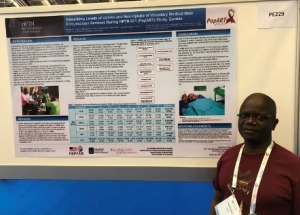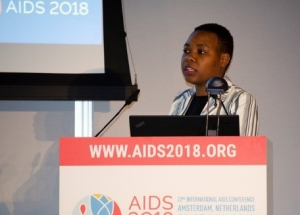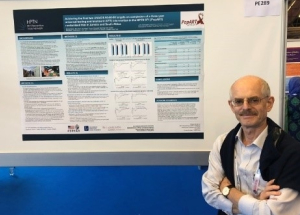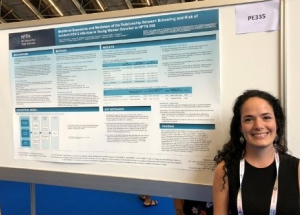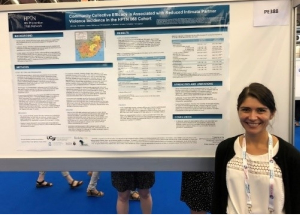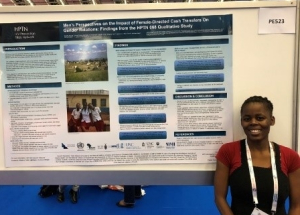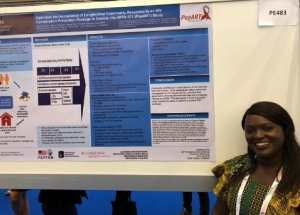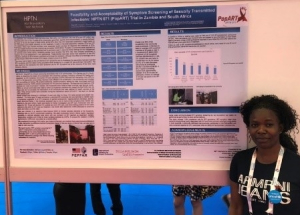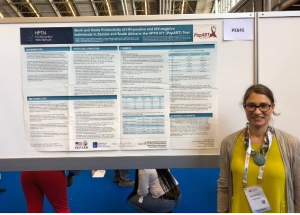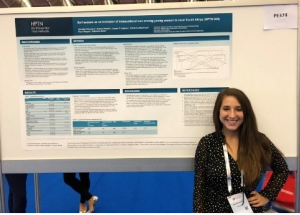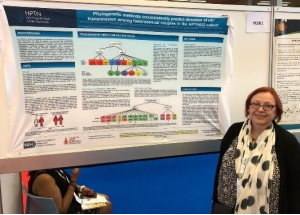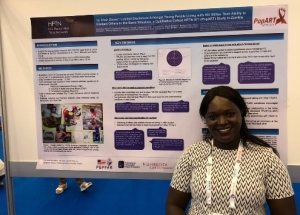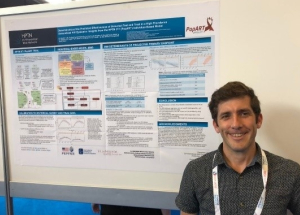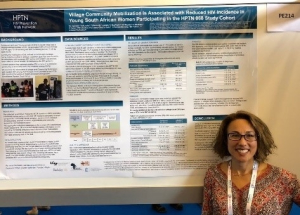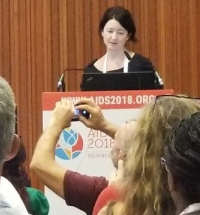AIDS 2018

The 22nd International AIDS Conference (AIDS 2018) was held July 23-27 at the RAI Amsterdam Convention Centre in Amsterdam, the Netherlands. HPTN researchers presented 31 posters and presentations covering HPTN 052, HPTN 068, HPTN 071 and HPTN 075. Network leadership also hosted a satellite session focused on the HPTN’s portfolio of clinical studies currently evaluating interventions that – if proven to be effective – can empower women to protect themselves from HIV infection. In addition, HPTN LOC staff hosted a booth in the Global Village, featuring information about the Network as well as ongoing and planned clinical trials.
HPTN Presented Research
The HPTN hosted HIV Prevention for Women, a standing-room-only satellite session chaired by HPTN Co-Principal Investigators Mike Cohen and Wafaa El-Sadr. Prevention of HIV in women is an urgent global priority and the HPTN is leading a vibrant research agenda evaluating ways to protect women worldwide from the infection. Session presenters shared insights from HPTN studies conducted in HIV-infected and uninfected women to evaluate interventions that may prevent the spread of HIV.
- Connie Celum, MD, MPH discussed Oral Pre-Exposure Prophylaxis (PrEP) for Prevention and concluded her talk with a brief video.
- Kwame Shanaube, MD, PhD discussed Acceptability of an HIV Prevention Package Among Young People.
- Audrey Pettifor, PhD, MPH discussed Structural and Social Factors That Contribute to Increased Vulnerability to HIV.
- Sinead Delany-Moretlwe, MBBCh, PhD, DTM&H discussed Long-Acting Injectables (LAIs) for PrEP

Nyaradzo Mgodi, MBChB, MMed, presented What’s New in the Pipeline for PrEP? sharing insights from several next-generation PrEP studies including the two antibody mediated prevention studies (HVTN 703/HPTN 081, HVTN 704/HPTN 085) and two long-acting injectable studies (HPTN 083, HPTN 084).
David Bonsall, MD, PhD, presented HIV Genotyping and Phylogenetics in the HPTN 071 (PopART) Study: Validation of a High-Throughput Sequencing Assay for Viral Load Quantification, Genotyping, Resistance Testing and High-Resolution Transmission Networking. The PopART phylogenetics sub-study will provide a valuable molecular epidemiological insight into the transmission events that occurred in-spite of the trials intervention. The team presented their low-cost next-generation sequencing solution, complete with analytics and specifically optimized to detect transmission, quantify viral load and predict drug resistance.
Christophe Fraser, PhD, presented Understanding Infection Clusters – Can This Help us to Target Prevention? explaining how HIV spreads and evolves over time and in different populations may improve control of the epidemic. Dr. Fraser described ways in which next-generation sequencing can be incorporated into prevention programs that are tailored to local populations along with the ethical and legal issues that may arise with this approach.
Kalpana Sabapathy, MBBS, PhD, MRCP, presented Estimates of coverage against the 90:90:90 UNAIDS targets: Comparison of methods and findings as part of a satellite session titled From Trials to Programmes: Lessons Learned from Four Trials of Universal Testing and Treatment (UTT) in sub-Saharan Africa, hosted by the Universal Test and Treat Trials Consortium (UT3C). The session was hosted by Richard Hayes, DSc, FMedSci (HPTN 071 protocol chair and UT3C chair) and David Serwadda, MD (HPTN Executive Committee Member) and featured field experiences and data to help inform public policy and resource allocation.

HPTN 052
Estelle Piwowar-Manning, MT, presented Evaluation of Phylogenetic Inference Methods to Determine Direction of HIV Transmission. Phylogenetic analysis of next-generation sequencing data obtained from samples collected within three months of transmission correctly determined the direction of transmission in 64 percent of the cases analyzed.
HPTN 068
SM DeLong, MPH, presented Trajectories of Physical Intimate Partner Violence (PIPV) Among Adolescent Girls in Rural South Africa: Who is at Consistently High Risk? (HPTN 068). Longitudinal patterns of PIPV varied among adolescent girls, with nearly two-thirds experiencing a consistently high probability of PIPV. Targeted intervention strategies tailored to those at higher risk could maximize reductions in PIPV.
Marie Stoner, PhD, presented Multilevel Exposures and Mediators of the Relationship Between Schooling and Risk of Incident HSV-2 Infection in Young Women Enrolled in HPTN 068. Low attendance in school was associated with a higher hazard of HSV-2 infection and partnership level factors were the most important mediators. The relationship between school attendance and HSV-2 was mediated primarily by having an age-disparate relationship and sex in the past 12 months.
Anna Leddy, PhD, presented Community Collective Efficacy is Associated with Reduced Intimate Partner Violence (IPV) Incidence in the HPTN 068 Cohort. Increased community-level collective efficacy (i.e., mutual trust among community members and willingness to intervene on the behalf of the common good) was associated with reduced physical intimate partner violence incidence among adolescent girls and young women in South Africa. These results support interventions that foster the development of collective efficacy at the community level which may improve HIV outcomes among this priority population.
Danielle Giovenco, PhD, presented Self-Esteem as an Indicator of Transactional Sex Among Young Women in Rural South Africa (HPTN 068). Findings provide support for the association between low self-esteem and transactional sex in this context. Future research should examine self-esteem and incident transactional sex to establish causality. Psychosocial factors, including self-esteem, should be considered when designing intervention programs.
Sheri Lippman, PhD, presented Village Community Mobilization is Associated with Reduced HIV Incidence in Young South African Women Participating in the HPTN 068 Study Cohort. These results support that living in a mobilized community, where communities work collectively and organize to address community welfare, can reduce adolescent girls and young women’s risk of HIV acquisition.
Nomhle Khoza presented Men's Perspectives on the Impact of Female-Directed Cash Transfers on Gender Relations: Findings from the HPTN 068 Qualitative Study. Findings reinforce evidence that cash transfers are not necessarily a source of tension or harm in male-female relationships. Linking cash transfer programs to HIV testing and other prevention services should be explored in future cash transfer programming.
Kait Atkins, MPH, presented “The Sky is the Limit; I am Going There": Exploring Hope Among Young Women Receiving a Conditional Cash Transfer in Rural South Africa. Conditional cash transfer (CCT) influence hope among young women in rural South Africa by alleviating routine stressors, promoting plans for higher education, and increasing confidence. By increasing women’s hope for a better life, CCT also reduces their desire to engage in HIV risk behaviors. However, these influences are highly reliant on baseline family and financial contexts.
HPTN 071
Mwelwa Phiri presented Community Condom Preferences in Zambia From the HPTN 071 (PopART) Trial. Quantitative and qualitative investigations of condom preferences show that distributing more interesting condoms (e.g., flavored, scented, female) than the government standard male condoms could improve condom uptake by as much as 60 percent in some groups, especially young women and men.
Ephraim Sakala presented Describing Levels of Uptake and Non-Uptake of Voluntary Medical Male Circumcision Services During HPTN 071 (PopART) Study, Zambia. Door-to-door information delivery and referral may contribute to uptake of voluntary medical male circumcision. However, just over one in four referred males went to the clinic and 93 percent of those who reached the health facility were circumcised. The high dropout may be resolved by intensified health education.
Comfort Phiri presented Feasibility and Acceptability of Symptom Screening of Sexually Transmitted Infections (STI): HPTN 071 (PopART) Trial in Zambia and South Africa. Large-scale community-based STI symptom screening by lay counsellors can easily be performed as part of door-to-door service delivery. Community members that previously participated in the intervention and were screened negative for STI, have lower odds for being STI symptomatic (Zambia only).
Kwame Shanaube, MD, PhD, presented HIV Care Cascade Among Adolescents in a “Test and Treat” Community Based Intervention in Zambia and South Africa: HPTN 071 (PopART) for Youth Study. Despite increased attention to adolescent HIV, gaps remain in the HIV care cascade by age and sex. Low knowledge of HIV status among adolescents remains one of the major gaps.
Mohammed Limbada, MD, presented Acceptability and Preferences of Two Different Community Models of ART Delivery in a High Prevalence Urban Setting in Zambia, Nested Within the HPTN 071 (PopART) Trial. Offering people living with HIV alternative options for ART delivery is highly acceptable in high-burden HIV resource limited urban settings with overburdened health care facilities.
In a poster discussion, Sian Floyd, MSc, presented Understanding Who Accepts and Who is Reached Through Secondary Distribution of HIV Self-Tests in a Cluster-Randomized Trial of Door-to-Door Offer of HIVST Nested in Four HPTN 071 (PopART) Communities in Zambia. Study staff conducting household visits offered to leave HIV self-test kits for use by absent household members (“secondary distribution” of kits). More than half of the kits left for secondary distribution (63.4 percent) were known to have been used, greater than 80 percent by male household members. Although less than 10 percent of individuals accepted a self-test kit for secondary distribution, secondary distribution reached men absent from the household, a population known to be difficult to reach.
Bernadette Hensen, PhD., presented Linkage to HIV Care Following HIV Self-Testing: A Cluster Randomized Trial of Community-Based Distribution of Oral HIV Self-Test Kits Nested in Four HPTN 071 Communities in Zambia. Linkage to HIV care (LTC) following an HIV-positive diagnosis and referral to HIV care was not undermined by offering HIVST as a testing option, in the context of LTC support.
In a poster discussion, Tila Mainga, MS, presented Adolescent and Young People’s Participation and Representation in Clinical Trials: Lessons from a Community-Wide HIV Testing and Treatment Study, the HPTN 071 (PopART) Study. Adolescents and young people can meaningfully participate in research by suggesting appropriate interventions and providing input to ensure that implementation of the research is ethical, and contextually and culturally sensitive. However, their participation may be constrained by high mobility leading to high turnover, and the requirement for parental/guardian permission.
Madalitso Mbewe, PhD, presented ‘In Their Shoes’: Limited Disclosure Amongst Young People Living with HIV Stifles Their Ability to Contact Others in the Same Situation, a Qualitative Cohort HPTN 071 (PopART) Study in Zambia. Young people living with HIV (YPLWH) often disclosed to very few or none of their peers despite having relatively wide social networks. These young people often desired support, however, and desired the opportunity to share experiences with other young people ‘in their shoes’. HIV self-management interventions for YPLWH should create opportunities for young people to support one another.
Rhoda Ndubani, MA, presented Optimism and Acceptance of Longitudinal Community Response to an HIV Combination Prevention Package in Zambia, the HPTN 071 (PopART) Study. Community confidence in home delivery of HIV services took time to build. Once established, better community management of HIV played out into optimism and appreciation of home delivered services and increasing reliance on community HIV care providers (CHiPs).
James Hargreaves, PhD, presented The HIV Stigma Landscape in Sub-Saharan Africa: Baseline Findings of a Mixed-Method, Comprehensive Evaluation Nested in the HPTN 071 (PopART) Trial. HIV stigma remains a commonly experienced phenomenon for people living with HIV. Going forward, it may be particularly important to address any negative effects of HIV stigma on treatment success, and to reduce stigma toward key populations.
Virginia Bond, PhD, presented “Self-Stigma is the Worst Kind of Stigma”: Internalized Stigma and Navigating HIV Care Amongst Health Workers Living with HIV in Zambia and South Africa, the HPTN 071 (PopART) Stigma Ancillary Study. Health workers-living with HIV reported concerning levels of internalised stigma. Self-stigma was especially evident in Zambian health facility workers, while more South African health workers reported not to be on treatment. Interventions are required to support those at the heart of HIV service delivery.
Richard Hayes, DSc, FMedSci, presented Achieving the First Two UNAIDS 90-90-90 Targets on Completion of a Three-Year Universal Testing and Treatment (UTT) Intervention in the HPTN 071 (PopART) Randomized Trial in Zambia and South Africa. After three annual rounds of the PopART intervention in these high mobility and migration urban communities, we estimated that the first and second 90 targets were achieved overall among adults aged 15 and older. In both countries, the targets were exceeded in women and almost reached among men. Continuing efforts are needed to reach remaining individuals living with HIV not yet diagnosed and on antiretroviral therapy and link them to care – particularly among younger adults (especially young men) where important gaps remain.
Sarah Fidler, MBBS, PhD, FRCP, presented Dramatic Reductions in Time to ART Initiation Among HIV+ Individuals Referred to HIV Care Following Home-Based Testing Services: Experiences from the HPTN 071 (PopART) Trial Between 2014 and 2017. Significant reductions were seen in the time taken from identification of people living with HIV by the community HIV care providers (CHiPs) , to initiation of antiretroviral therapy over the three annual rounds(from an average of ~10 months to ~3 months).
David Macleod, PhD, presented Retention on ART Within the HPTN 071 (PopART) Universal Testing and Treatment Programme in Zambia and South Africa. Estimates of retention on antiretroviral therapy (ART) were calculated based on self-reported data from people living with HIV in the seven study communities that received the full study intervention from the start of the trial. In the absence of routine viral load testing, these results provide some indication that retention on ART within the study was high, a necessary component in order to meet the “third 90” of the UNAIDS 90-90-90 targets.
Blia Yang presented HIV Testing Patterns in Two Community-Based Approaches to Universal Test and Treat in the HPTN 071 (PopART) Intervention in South Africa. Tent-HIV testing services in high traffic areas proved successful in reaching men, although the absolute number of additional tests was relatively small. Tent-HIV testing services was also relatively more successful in agricultural areas.
Neshaan Peton, MPA, presented How Health Workers Motivated People Living with HIV (PLHIV) to Initiate Antiretroviral Treatment at High CD4 Counts in Three HPTN 071 (PopART) Health Facilities, Western Cape, South Africa. Motivating patients to initiate antiretroviral therapy at high CD4 counts is possible even in high burden settings.
Ranjeeta Thomas, PhD, presented Costs of Two Rounds of Home-Based HIV Testing in Zambia: Evidence from the HPTN 071 (PopART) Study. The findings suggest costs are sensitive to community-specific factors related to service delivery or population characteristics. The cost per person tested HIV-positive nearly doubled between rounds, which is partly explained by a reduction in the number of persons tested HIV-positive in the second round.
Katharina Hauck, PhD, presented Work and Home Productivity of HIV-Positive and HIV-Negative Individuals in Zambia and South Africa in the HPTN 071 (PopART) Trial. There is a significant burden in lost work and home productivity due to HIV in the general population, but it is smaller than existing estimates for samples dominated by formal sector workers. Productive days lost need to be considered when evaluating the benefit of HIV prevention from a societal perspective.
Rafael Sauter, PhD, presented Determinants of the Predicted Effectiveness of Universal Test and Treat (UTT) in a High Prevalence Generalized HIV Epidemic: Insights from the HPTN 071 (PopART) Individual-Based Model. The choice of individual-based simulation model parameters has a substantial effect on the predicted trial outcome. Detailed modelling of the trial allows identification of determinants of effectiveness, that will in turn improve long-term modelling projections, offering insight into developments far beyond the trial horizon, relevant for decisions to be taken after trial completion.
Kalpana Sabapathy, MBBS, PhD, MRCP, presented Intimate Partner Violence and Associated Factors in HPTN 071 (PopART) Study Communities – A Comparison by HIV Status. The prevalence of intimate partner violence was not associated with uptake of home-based testing or timely antiretroviral therapy initiation among women who participated in our study suggesting that women experiencing intimate partner violence were not excluded by PopART interventions. This is encouraging for ensuring universal coverage with similar approaches.
HPTN 075
Kenneth Ondeng’e, MPH, presented Bisexuality Among Men Who Have Sex with Men and Transgender Women in Sub-Saharan Africa: Findings from the HPTN 75 Study. Findings demonstrate there is a substantial proportion of sub-Saharan African men who have sex with men and transgender women who recently have engaged in sex with both men and women. In-depth understanding of their practices presents an opportunity for developing targeted public health interventions.
